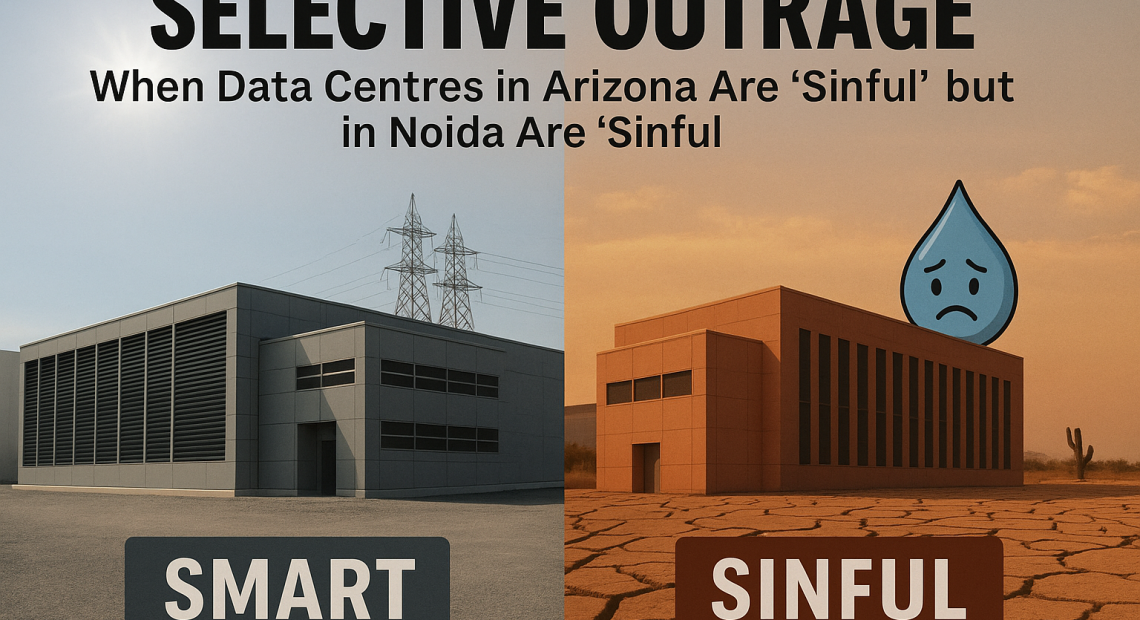
Selective Outrage: When Data Centres in Arizona Are ‘Smart’ but in Noida Are ‘Sinful’
India’s data revolution was supposed to be our great digital equaliser — until the moral gatekeepers of the “green conscience” found a new villain: the data centre. The same facilities that power AI, banking, healthcare, and governance are now being recast as water-guzzling monsters. Publications like Down to Earth are suddenly discovering groundwater as if data servers alone have been sucking India dry, not the luxury villas, golf courses, or gated colonies of the urban elite. The environmental Left’s new crusade isn’t about saving water. It’s about policing progress.
In the United States, Google and Microsoft are quietly running data centres in Arizona and Nevada, two of the driest regions on Earth. In Oregon, a single Google facility at The Dalles reportedly consumed 355 million gallons of water in one year — enough to supply an entire town. Yet Western media calls these “smart infrastructure investments.” Meanwhile, India’s facilities in Noida and Navi Mumbai, which are increasingly using recycled water and closed-loop cooling systems, are branded “unsustainable.” When Silicon Valley guzzles, it’s innovation. When Noida builds servers, it’s sin.
The arithmetic that activists conveniently ignore is simple. A 1 MW data centre typically consumes around 26 million litres of water per year. A golf course uses over 100 million litres. A luxury housing complex can top 400 million litres annually. And agriculture — the country’s largest water consumer — wastes more than 60% of the water it draws due to outdated irrigation practices. But apparently, a handful of digital parks that run India’s online backbone are the real villains. If “digital thirst” is an ecological disaster, then private swimming pools should be declared national emergencies.
This hypocrisy is not accidental. It’s ideological. The eco-Left’s script has always been the same: development in the West is “progress,” but in India, it’s “exploitation.” The same NGOs and think tanks that call desert data centres in America “sustainable cloud ecosystems” label Indian ones “corporate greed.” Their problem isn’t that India is growing—it’s that India is growing without permission. Every megawatt of Indian digital capacity chips away at the West’s monopoly on data, AI, and cloud infrastructure. That’s the real reason for the moral outrage masquerading as environmental concern. It’s not about water—it’s about control of the cloud.
The ecosystem of “climate watchdogs” functions like a global PR machine. Activist journalists write alarmist pieces. Western-funded NGOs amplify them as “research.” And international donors quote those reports to justify conditional funding or to shame Indian policymakers into “reforms.” It’s not journalism—it’s geopolitics wrapped in guilt. The tragedy is that many Indian publications, like Down to Earth, have become unwitting echo chambers for this imported moral framework, parroting the same talking points that keep developing nations forever defensive.
India’s data centre boom is not reckless—it’s responsible. The government’s National Data Centre Policy mandates sustainability guidelines, and most major operators already rely on treated or non-potable water. Several new facilities are integrating air-cooling systems that require negligible water compared to traditional evaporative methods. India is building its digital backbone faster and cleaner than any Western economy did at a similar stage of development. Yet instead of applause, we get sermons.
The truth is simple: the Western environmental establishment can’t stand losing the monopoly on technological virtue. The same nations that built empires burning coal and oil now lecture the rest of the world for wanting electricity to run a server. Their guilt is global—but their outrage is selective.
When data centres in deserts are applauded and those in drylands are condemned, it’s not science—it’s prejudice dressed up as climate virtue.


















